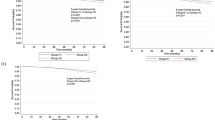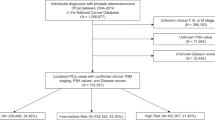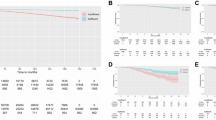Abstract
Background:
We aimed to assess the prognostic relevance of the new Grade Groups in Prostate Cancer (PCa) within a large cohort of European men treated with radical prostatectomy (RP).
Methods:
Data from 27 122 patients treated with RP at seven European centers were analyzed. We investigated the prognostic performance of the new Grade Groups (based on Gleason score 3+3, 3+4, 4+3, 8 and 9–10) on biopsy and RP specimen, adjusted for established clinical and pathological characteristics. Multivariable Cox proportional hazards regression models assessed the association of new Grade Groups with biochemical recurrence (BCR). Prognostic accuracies of the models were assessed using Harrell’s C-index.
Results:
Median follow-up was 29 months (interquartile range, 13–54). The 4-year estimated BCR-free survival (bRFS) for biopsy Grade Groups 1–5 were 91.3, 81.6, 69.8, 60.3 and 44.4%, respectively. The 4-year estimated bRFS for RP Grade Groups 1–5 were 96.1%, 86.7%, 67.0%, 63.1% and 41.0%, respectively. Compared with Grade Group 1, all other Grade Groups based both on biopsy and RP specimen were independently associated with a lower bRFS (all P<0.01). Adjusted pairwise comparisons revealed statistically differences between all Grade Groups, except for group 3 and 4 on RP specimen (P=0.10). The discriminations of the multivariable base prognostic models based on the current three-tier and the new five-tier systems were not clinically different (0.3 and 0.9% increase in discrimination for clinical and pathological model).
Conclusions:
We validated the independent prognostic value of the new Grade Groups on biopsy and RP specimen from European PCa men. However, it does not improve the accuracies of prognostic models by a clinically significant margin. Nevertheless, this new classification may help physicians and patients estimate disease aggressiveness with a user-friendly, clinically relevant and reproducible method.
This is a preview of subscription content, access via your institution
Access options
Subscribe to this journal
Receive 4 print issues and online access
$259.00 per year
only $64.75 per issue
Buy this article
- Purchase on Springer Link
- Instant access to full article PDF
Prices may be subject to local taxes which are calculated during checkout

Similar content being viewed by others
References
Brimo F, Montironi R, Egevad L, Erbersdobler A, Lin DW, Nelson JB et al. Contemporary grading for prostate cancer: implications for patient care. Eur Urol 2013; 63: 892–901.
Heidenreich A, Bastian PJ, Bellmunt J, Bolla M, Joniau S, van der Kwast T et al. EAU guidelines on prostate cancer. part 1: screening, diagnosis, and local treatment with curative intent-update 2013. Eur Urol 2014; 65: 124–137.
Gleason DF, Mellinger GT . Prediction of prognosis for prostatic adenocarcinoma by combined histological grading and clinical staging. J Urol 1974; 111: 58–64.
Epstein JI, Allsbrook WC Jr., Amin MB, Egevad LL . The 2005 International Society of Urological Pathology (ISUP) Consensus Conference on Gleason Grading of Prostatic Carcinoma. Am J Surg Pathol 2005; 29: 1228–1242.
Epstein JI, Egevad L, Amin MB, Delahunt B, Srigley JR, Humphrey PA . The 2014 International Society of Urological Pathology (ISUP) Consensus Conference on Gleason Grading of Prostatic Carcinoma: definition of grading patterns and proposal for a new grading system. Am J Surg Pathol 2016; 40: 244–252.
Humphrey PA, Moch H, Cubilla AL, Ulbright TM, Reuter VE . The 2016 WHO Classification of Tumours of the Urinary System and Male Genital Organs-Part B: prostate and bladder tumours. Eur Urol 2016; 70: 106–119.
Zietman A, Smith J, Klein E, Droller M, Dasgupta P, Catto J . Consensus guidelines for reporting prostate cancer Gleason Grade. BJU Int 2016; 117: 849.
Spratt DE, Jackson WC, Abugharib A, Tomlins SA, Dess RT, Soni PD et al. Independent validation of the prognostic capacity of the ISUP prostate cancer grade grouping system for radiation treated patients with long-term follow-up. Prostate Cancer Prostatic Dis 2016; 19: 292–297.
Pierorazio PM, Walsh PC, Partin AW, Epstein JI . Prognostic Gleason grade grouping: data based on the modified Gleason scoring system. BJU Int 2013; 111: 753–760.
Spratt DE, Cole AI, Palapattu GS, Weizer AZ, Jackson WC, Montgomery JS et al. Independent surgical validation of the new prostate cancer grade groupingsystem. BJU Int 2016; 118: 763–769.
Samaratunga H, Delahunt B, Gianduzzo T, Coughlin G, Duffy D, LeFevre I et al. The prognostic significance of the 2014 International Society of Urological Pathology (ISUP) grading system for prostate cancer. Pathology 2015; 47: 515–519.
Epstein JI, Zelefsky MJ, Sjoberg DD, Nelson JB, Egevad L, Magi-Galluzzi C et al. A contemporary prostate cancer grading system: a validated alternative to the gleason score. Eur Urol. 2016; 69: 428–435.
van den Bergh RC, van der Kwast TH, de Jong J, Zargar H, Ryan AJ, Costello AJ et al. Validation of the novel ISUP-2014 5-tier Gleason grade grouping: biochemical recurrence rates of 3+5 disease may be overestimated. BJU Int 2016; 118: 502–505.
Delahunt B, Egevad L, Srigley JR, Steigler A, Murray JD, Atkinson C et al. Validation of International Society of Urological Pathology (ISUP) grading for prostatic adenocarcinoma in thin core biopsies using TROG 03.04 ‘RADAR’ trial clinical data. Pathology 2015; 47: 520–525.
Loeb S, Folkvaljon Y, Robinson D, Lissbrant IF, Egevad L, Stattin P . Evaluation of the 2015 Gleason Grade Groups in a Nationwide Population-based Cohort. Eur Urol 2015; 69: 1135–1141.
Lau WK, Blute ML, Bostwick DG, Weaver AL, Sebo TJ, Zincke H . Prognostic factors for survival of patients with pathological Gleason score 7 prostate cancer: differences in outcome between primary Gleason grades 3 and 4. J Urol 2001; 166: 1692–1697.
Koontz BF, Tsivian M, Mouraviev V, Sun L, Vujaskovic Z, Moul J et al. Impact of primary Gleason grade on risk stratification for Gleason score 7 prostate cancers. Int J Radiat Oncol Biol Phys 2012; 82: 200–203.
Stark JR, Perner S, Stampfer MJ, Sinnott JA, Finn S, Eisenstein AS et al. Gleason score and lethal prostate cancer: does 3+4=4+3? J Clin Oncol 2009; 27: 3459–3464.
Alenda O, Ploussard G, Mouracade P, Xylinas E, de la Taille A, Allory Y et al. Impact of the primary Gleason pattern on biochemical recurrence-free survival after radical prostatectomy: a single-center cohort of 1,248 patients with Gleason 7 tumors. World J Urol 2011; 29: 671–676.
Tollefson MK, Leibovich BC, Slezak JM, Zincke H, Blute ML . Long-term prognostic significance of primary Gleason pattern in patients with Gleason score 7 prostate cancer: impact on prostate cancer specific survival. J Urol 2006; 175: 547–551.
Burdick MJ, Reddy CA, Ulchaker J, Angermeier K, Altman A, Chehade N et al. Comparison of biochemical relapse-free survival between primary Gleason score 3 and primary Gleason score 4 for biopsy Gleason score 7 prostate cancer. Int J Radiat Oncol Biol Phys 2009; 73: 1439–1445.
Tsao CK, Gray KP, Nakabayashi M, Evan C, Kantoff PW, Huang J et al. Patients with biopsy Gleason 9 and 10 prostate cancer have significantly worse outcomes compared to patients with Gleason 8 disease. J Urol 2015; 194: 91–97.
Loeb S, Curnyn C, Sedlander E . Perspectives of prostate cancer patients on Gleason Scores and the new Grade Groups: initial qualitative study. Eur Urol 2016; 70: 1083–1085.
Zumsteg ZS, Spratt DE, Pei I, Zhang Z, Yamada Y, Kollmeier M et al. A new risk classification system for therapeutic decision making with intermediate-risk prostate cancer patients undergoing dose-escalated external-beam radiation therapy. Eur Urol 2013; 64: 895–902.
Berney DM, Beltran L, Fisher G, North BV, Greenberg D, Moller H et al. Validation of a contemporary prostate cancer grading system using prostate cancer death as outcome. Br J Cancer 2016; 114: 1078–1083.
Shariat SF, Kattan MW, Erdamar S, Nguyen C, Scardino PT, Spencer DM et al. Detection of clinically significant, occult prostate cancer metastases in lymph nodes using a splice variant-specific rt-PCR assay for human glandular kallikrein. J Clin Oncol 2003; 21: 1223–1231.
Shariat SF, Gottenger E, Nguyen C, Song W, Kattan MW, Andenoro J et al. Preoperative blood reverse transcriptase-PCR assays for PSA and human glandular kallikrein for prediction of prostate cancer progression after radical prostatectomy. Cancer Res 2002; 62: 5974–5979.
Author information
Authors and Affiliations
Corresponding author
Ethics declarations
Competing interests
The authors declare no conflict of interest.
Rights and permissions
About this article
Cite this article
Mathieu, R., Moschini, M., Beyer, B. et al. Prognostic value of the new Grade Groups in Prostate Cancer: a multi-institutional European validation study. Prostate Cancer Prostatic Dis 20, 197–202 (2017). https://doi.org/10.1038/pcan.2016.66
Received:
Revised:
Accepted:
Published:
Issue Date:
DOI: https://doi.org/10.1038/pcan.2016.66
This article is cited by
-
Prediction of disease progression indicators in prostate cancer patients receiving HDR-brachytherapy using Raman spectroscopy and semi-supervised learning: a pilot study
Scientific Reports (2022)
-
Comparative Effectiveness of Radiotherapy versus Focal Laser Ablation in Patients with Low and Intermediate Risk Localized Prostate Cancer
Scientific Reports (2020)
-
The new ISUP 2014/WHO 2016 prostate cancer grade group system: first résumé 5 years after introduction and systemic review of the literature
World Journal of Urology (2020)
-
Der aktuelle Stand beim Gleason-Score
Uro-News (2019)
-
Prostate cancer grading: a decade after the 2005 modified system
Modern Pathology (2018)



